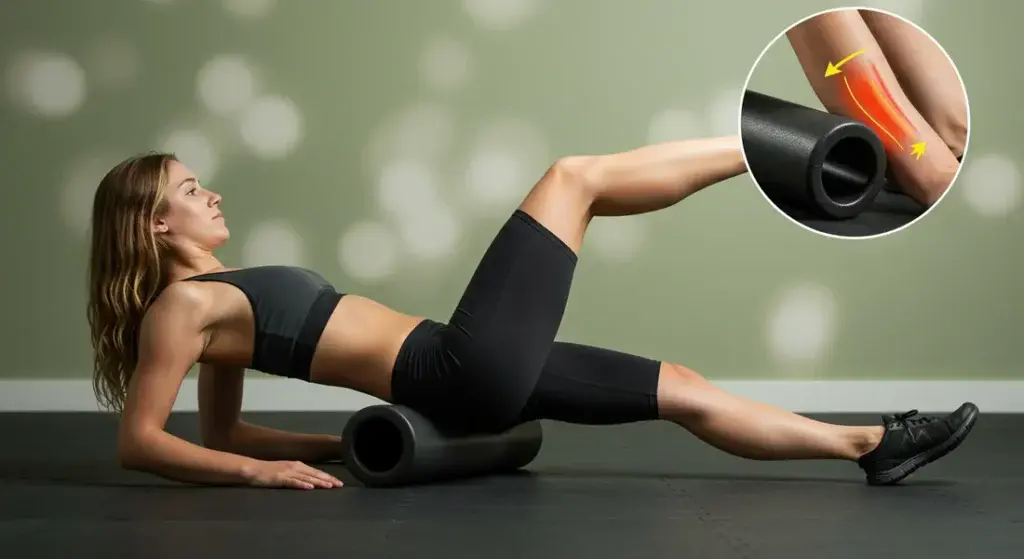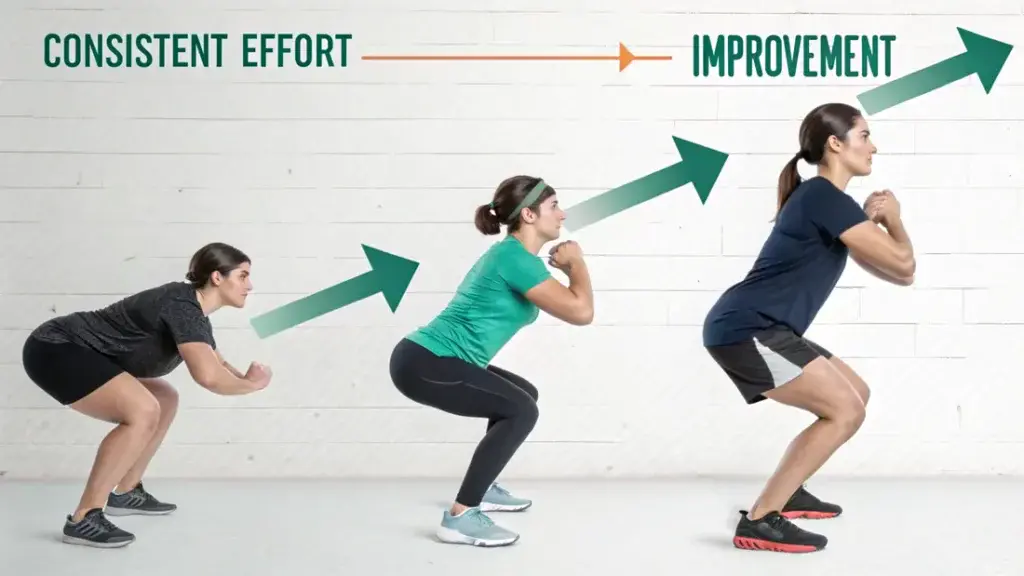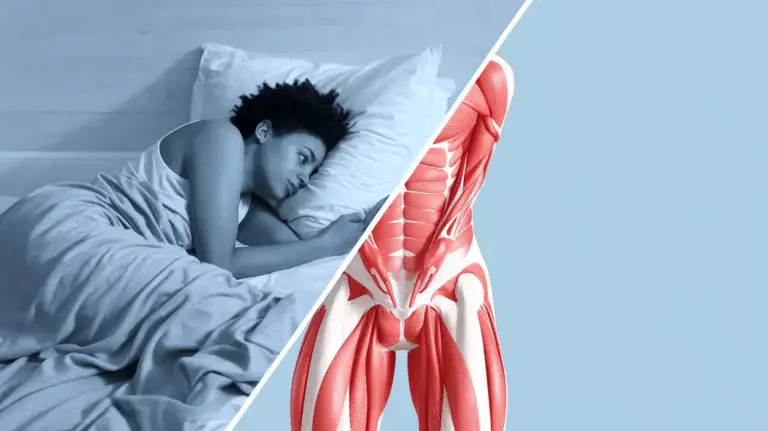Are you struggling to reach full depth in your squats or experiencing discomfort when you try to go lower?
You’re not alone.

Many fitness enthusiasts hit a plateau with their squat performance despite consistent training.
The missing link might not be in your technique or strength, but in an often-overlooked aspect of mobility – your hip flexors.
Hip flexor mobility is frequently the hidden key that can unlock your true squat potential.
In this guide, we’ll explain why hip flexor mobility matters so much for squats and provide you with actionable steps to improve it, leading to deeper, safer, and more effective squats.
Understanding Your Hip Flexors – The Unsung Heroes of Movement
What Are Hip Flexors?
Hip flexors are a group of muscles located at the front of your hip that are responsible for lifting your leg toward your torso.
They play a crucial role in many everyday movements and are especially important in exercises like squats.
Key Hip Flexor Muscles
The primary hip flexor muscles include:
- Iliopsoas: This is actually two muscles working together—the iliacus and the psoas major. This is the most powerful hip flexor group.
- Rectus Femoris: Part of your quadriceps that also crosses the hip joint.
- Sartorius: The longest muscle in the body, running from the outside of the hip to the inside of the knee.

Their Role in Movement
Your hip flexors are engaged in nearly all lower body movements, including walking, running, climbing stairs, and crucially, squatting.
During a squat, your hip flexors work to control the descent by allowing your thighs to move closer to your torso, enabling that crucial depth that many strive for.
The Impact of Tight Hip Flexors on Your Squat
Limited Squat Depth
Tight hip flexors significantly restrict the range of motion available at your hip joint.
This limitation directly impacts your ability to descend into a deep squat position.
When your hip flexors lack proper mobility, you’ll find yourself stopping short of full depth, regardless of how much you try to push through it.
Compromised Form and Safety
When hip flexors are tight, your body naturally looks for ways to compensate to achieve depth.
These compensatory movements often include:
- Excessive anterior pelvic tilt (arching of the lower back)
- Rounding of the lower back
- Knees caving inward
- Heels lifting off the ground
These compensations not only reduce the effectiveness of the exercise but also significantly increase your risk of injury, particularly to your lower back and knees.
Inefficient Movement
Restricted hip flexors create inefficient movement patterns throughout the entire squat.
This inefficiency can lead to energy leaks, reduced power output, and an inability to handle heavier loads safely.
The result is a squat that feels more difficult than it should and delivers fewer benefits than it could.
Table 1: Common Signs of Tight Hip Flexors
| Sign | Description |
| Limited Squat Depth | Inability to descend below parallel despite adequate ankle and knee mobility |
| Anterior Pelvic Tilt | Forward tilt of the pelvis that increases lower back arch |
| Lower Back Pain | Discomfort in the lumbar region during or after squats |
| Knee Tracking Issues | Knees caving inward (valgus collapse) during descent |
| Hip Impingement | Pinching sensation at the front of the hip in deep squat positions |
Why Hip Flexors Get Tight (and How it Relates to Squats)
Prolonged Sitting
Modern lifestyles involve hours of sitting—at desks, in cars, and on couches.
This prolonged sitting keeps your hip flexors in a shortened position for extended periods, eventually leading to adaptive shortening where the muscles become chronically tight and resistant to lengthening.
Repetitive Movements
Certain activities, including running, cycling, and even improperly performed squats, can contribute to hip flexor tightness.
These repetitive movements, especially when not balanced with proper mobility work, can create muscle imbalances that affect your squat.
Lack of Stretching
Many workout routines focus heavily on strengthening without adequately addressing mobility.
Without regular stretching and mobility work specifically targeting the hip flexors, these muscles can become increasingly restrictive over time.
Simple Yet Effective Hip Flexor Stretches for Squatters
Kneeling Hip Flexor Stretch
- Kneel on one knee with your other foot flat on the floor in front of you (similar to a proposal position).
- Keep your back straight and core engaged.
- Gently push your hips forward until you feel a stretch in the front of your hip on the kneeling leg.
- For a deeper stretch, raise the arm on the same side as your kneeling leg overhead and lean slightly to the opposite side.
- Hold for 30 seconds, then switch sides.
This stretch directly targets the iliopsoas, the primary hip flexor muscle group.
Standing Hip Flexor Stretch
- Stand with your feet staggered, one foot about two feet in front of the other.
- Bend your front knee while keeping your back leg straight.
- Tuck your pelvis under slightly (posterior pelvic tilt) to intensify the stretch.
- Place your hands on your front thigh for support if needed.
- Hold for 30 seconds, then switch sides.
Lunges as a Stretch
- Step forward into a lunge position.
- Lower your back knee toward the ground.
- Keep your torso upright and core engaged.
- Gently press your hips forward and down to feel the stretch in your rear hip flexor.
- Hold for 30 seconds, then switch sides.
Dynamic lunges can also be incorporated into your warm-up routine.
Supine Hip Flexor Stretch
- Lie on your back near the edge of a bed or bench.
- Bring both knees toward your chest.
- Hold one knee against your chest while lowering the other leg down toward the floor.
- Allow gravity to gently stretch the hip flexor of the lowered leg.
- Hold for 30 seconds, then switch sides.
This is a gentler option for those with more significant tightness or discomfort.
Remember to warm up before stretching and hold each stretch for at least 30 seconds to effectively lengthen the muscle.
Repeat each stretch on both sides, even if one side feels tighter than the other.
Table 2: Hip Flexor Stretches – Summary Guide
| Stretch | Target Muscles | Difficulty | Duration | Frequency |
| Kneeling Hip Flexor | Iliopsoas | Beginner | 30 sec/side | Daily |
| Standing Hip Flexor | Iliopsoas, Rectus Femoris | Beginner | 30 sec/side | Daily |
| Lunges as Stretch | Hip Flexor Complex | Intermediate | 30 sec/side | Daily |
| Supine Hip Flexor | Iliopsoas, Sartorius | Beginner | 30-45 sec/side | Daily |
| Foam Rolling Hip Flexors | All Hip Flexors | Intermediate | 1-2 min/side | 4-5x/week |
Strengthening Hip Flexors (Yes, They Need Strength Too!)
While mobility is crucial, having strong hip flexors is equally important for optimal squat performance.
Weak hip flexors can’t properly control the descent into a squat, potentially leading to instability and poor mechanics.
Straight Leg Raises
- Lie on your back with one leg extended and the other bent with foot flat on the floor.
- Keeping the extended leg straight, lift it to the height of your bent knee.
- Slowly lower back down without touching the floor.
- Perform 3 sets of 10-15 repetitions on each leg.
Lunges as a Strengthening Exercise
- Step forward into a lunge position.
- Lower your back knee toward the floor without touching it.
- Push through your front heel to return to standing.
- Perform 3 sets of 10-12 repetitions on each leg.
Lunges serve the dual purpose of stretching and strengthening the hip flexors.
Mountain Climbers
- Start in a high plank position with arms straight and core engaged.
- Bring one knee toward your chest, then quickly alternate legs.
- Maintain a strong plank position throughout the movement.
- Perform 3 sets of 30-45 seconds.
This dynamic exercise engages the hip flexors while also providing cardio benefits.
Bridge Exercise
- Lie on your back with knees bent and feet flat on the floor.
- Lift your hips toward the ceiling, creating a straight line from knees to shoulders.
- Squeeze your glutes at the top of the movement.
- Slowly lower back down and repeat.
- Perform 3 sets of 12-15 repetitions.
While primarily a glute exercise, bridges help create balance between the anterior and posterior hip muscles, indirectly supporting hip flexor function.
Aim to incorporate these strengthening exercises 2-3 times per week for optimal results.
Table 3: Hip Flexor Strengthening Exercises – Program Guide
| Exercise | Sets | Reps/Duration | Difficulty | Frequency |
| Straight Leg Raises | 3 | 10-15 reps/side | Beginner | 2-3x/week |
| Walking Lunges | 3 | 10-12 reps/side | Intermediate | 2-3x/week |
| Mountain Climbers | 3 | 30-45 seconds | Intermediate | 2-3x/week |
| Bridge Exercise | 3 | 12-15 reps | Beginner | 2-3x/week |
Integrating Hip Flexor Work into Your Squat Routine
Pre-Squat Warm-up
Before squatting, prepare your hip flexors with dynamic movements such as:
- Leg swings (forward and back, side to side)
- Hip circles
- Walking lunges
- Light bodyweight squats with progressive depth
These movements increase blood flow to the hip flexors and prepare them for the demands of squatting.
Post-Squat Cool-down
After completing your squat session, dedicate time to static hip flexor stretches.
Your muscles will be warm and more receptive to stretching, making this an ideal time to improve flexibility.
Consistency is Key
For noticeable improvements in your squat depth and form, perform hip flexor mobility work consistently—not just on squat days.
Incorporate short mobility sessions into your daily routine, especially if you spend significant time sitting.
Beyond Stretches – Additional Tips for Hip Flexor Health and Squats

Foam Rolling
Foam rolling the hip flexors and surrounding muscles can help release tension and improve tissue quality:
- Position the foam roller under the front of your hip.
- Support yourself with your forearms on the ground.
- Slowly roll up and down the length of your hip flexors.
- When you find a tender spot, pause and apply pressure for 20-30 seconds before continuing.
Proper Posture
Your daily posture significantly impacts your hip flexor health.
Practice maintaining a neutral spine and pelvis position both during exercise and throughout your day.
Avoid excessive anterior pelvic tilt, which can place the hip flexors in a shortened position.
Regular Movement Breaks
If your job requires prolonged sitting, set reminders to stand up and move every 30-60 minutes.
Simple movements like standing hip flexor stretches or walking around the office can help prevent adaptive shortening of these important muscles.
Listen to Your Body – Addressing Pain and Limitations
While working on hip flexor mobility, it’s important to distinguish between the normal sensation of stretching and actual pain.
You should feel a stretching or pulling sensation, but it should not be sharply painful.
If you experience sharp or persistent pain in your hip flexor region, especially during squats, stop the activity and consider consulting with a physical therapist or qualified fitness professional.
They can provide personalized guidance and ensure you’re not dealing with an injury that requires specific treatment.
Conclusion – Unlock Your Full Squat Potential

Hip flexor mobility isn’t just a minor detail in squat performance—it’s often the crucial factor that separates average squats from excellent ones.
By understanding the role these muscles play and consistently working on both their mobility and strength, you can unlock your full squat potential.
The benefits extend beyond just deeper squats. Improved hip flexor mobility contributes to better movement patterns in daily life, reduced risk of injuries, and enhanced athletic performance across various activities.
Incorporate the stretches, strengthening exercises, and mobility techniques outlined in this guide into your routine.
Be patient with the process—meaningful mobility improvements take time, but the results in your squat depth, form, and safety will be well worth the effort.
RetryI
Reference Section
- Yamane M, Aoki M, Sasaki Y, Kawaji H. Understanding the Muscle Activity Pattern of the Hip Flexors during Straight Leg Raising in Healthy Subjects. Prog Rehabil Med. 2019 Feb 16;4:20190007. doi: 10.2490/prm.20190007. PMID: 32789254; PMCID: PMC7365227.
- Biscarini A, Botti FM, Pettorossi VE. Selective contribution of each hamstring muscle to anterior cruciate ligament protection and tibiofemoral joint stability in leg-extension exercise: a simulation study. Eur J Appl Physiol. 2013 Sep;113(9):2263-73. doi: 10.1007/s00421-013-2656-1. Epub 2013 May 14. PMID: 23670482.
- Cronin J, Nash M, Whatman C. The acute effects of hamstring stretching and vibration on dynamic knee joint range of motion and jump performance. Phys Ther Sport. 2008 May;9(2):89-96. doi: 10.1016/j.ptsp.2008.01.003. Epub 2008 Apr 3. PMID: 19083708.
- Machotka Z, Kumar S, Perraton LG. A systematic review of the literature on the effectiveness of exercise therapy for groin pain in athletes. Sports Med Arthrosc Rehabil Ther Technol. 2009 Mar 31;1(1):5. doi: 10.1186/1758-2555-1-5. PMID: 19331695; PMCID: PMC2674034.
- Kang SY, Jeon HS, Kwon O, Cynn HS, Choi B. Activation of the gluteus maximus and hamstring muscles during prone hip extension with knee flexion in three hip abduction positions. Man Ther. 2013 Aug;18(4):303-7. doi: 10.1016/j.math.2012.11.006. Epub 2013 Jan 9. PMID: 23312068.
- Kwon YJ, Lee HO. How different knee flexion angles influence the hip extensor in the prone position. J Phys Ther Sci. 2013 Oct;25(10):1295-7. doi: 10.1589/jpts.25.1295. Epub 2013 Nov 20. PMID: 24259779; PMCID: PMC3820173.
- Neto WK, Soares EG, Vieira TL, Aguiar R, Chola TA, Sampaio VL, Gama EF. Gluteus Maximus Activation during Common Strength and Hypertrophy Exercises: A Systematic Review. J Sports Sci Med. 2020 Feb 24;19(1):195-203. PMID: 32132843; PMCID: PMC7039033.
- Straub RK, Powers CM. A Biomechanical Review of the Squat Exercise: Implications for Clinical Practice. Int J Sports Phys Ther. 2024 Apr 1;19(4):490-501. doi: 10.26603/001c.94600. PMID: 38576836; PMCID: PMC10987311.
- Forte P, Teixeira JE. Exercise Biomechanics for Health: Evaluating Lifelong Activities for Well-Being. Healthcare (Basel). 2023 Mar 21;11(6):900. doi: 10.3390/healthcare11060900. PMID: 36981557; PMCID: PMC10048551.



